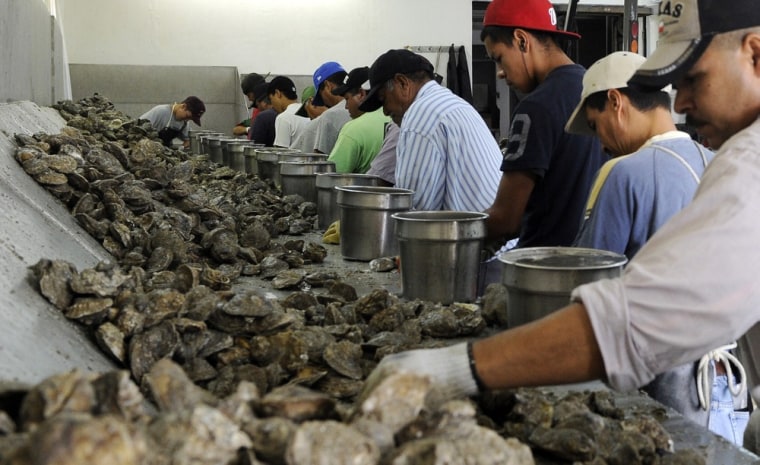Tracy Woody heaved a hemp bag filled with oysters across the deck of his boat and began inspecting his catch. One shell after another was empty.
It's virtually official, Woody said: the third-worst drought in state history has killed any hope that Texas oysters would make up for the severe losses in Mississippi and Louisiana, where the shellfish suffered from last year's oil spill and this year's massive flooding.
"There's no way," said Woody, a fifth-generation oyster fisherman who says he has never seen conditions this bad.
Oysters are a $217 million industry on the Gulf Coast. Louisiana and Texas account for 70 percent of the eastern species found in the Gulf and along the East Coast. Pessimism about the harvest this season is growing, even though experts won't offer a specific projection.
This year, the drought has made the water in Texas' Galveston Bay, where most of the state's oysters are harvested, so salty that predators and disease are thriving. Conditions are so dire, the deadly "dermo" parasite has been found in two reefs where it's never been seen before.
Combined with the losses in the southeastern states, consumers may be hard-pressed to find Gulf Coast oysters this year.
"There's not going to be enough oysters, the price is going to go through the roof and the consumers are not going to pay," Woody said, as workers threw hemp sacks of oysters onto wooden pallets.
Shrimp and blue crabs may also be affected by the drought. Shrimp has the biggest share of Texas' commercial fishing business, with $236 million in revenue in 2009; oysters follow, pulling in some $28 million in 2009, an off-year because of Hurricane Ike and other factors.
Galveston Bay has not experienced such high salinity since at least the 1980s, said Lance Robinson, regional director of the coastal fisheries division of the Texas Parks and Wildlife Department. "This is unprecedented," he said.
In normal years, rain in Central and North Texas fills the rivers and streams. The fresh water flows down to the Gulf and mixes with saltwater in the bays and estuaries. This environment allows oysters to thrive and reproduce. This year, there has been less than six inches of rain on average in Texas, compared to 13 inches normally.
Some believe that only about 40 inches of rain in the Dallas area would help at this point — and it may be too late.
"If we don't get a break in the drought, I think in Texas we will find when the season opens in November most of our bays will have nothing but dead shell," said Sammy Ray, a shellfish pathologist at Texas A&M University in Galveston.
Right now, oyster fishermen like Woody are harvesting leased reefs. The public oyster fishing season runs from November through April. At that time, Woody jumps from six active boats to 12. The 60 or so workers he has now on fishing boats, on the docks and in the shucking room, increases to about 140.
This year, however, Woody is not optimistic. He and the other fishermen have still not recovered from Hurricane Ike, the massive storm in 2008 that covered reefs in sediment and buried oysters in mud.
Then, the price of oysters rose to $12 a pound. Woody kept his prices at $9 and sold only to his best customers. Woody has already used up his surplus supply of oysters. He has barely planted new shell and rock on his reefs this year because of the high salinity.
"If it keeps on this path our business is not going to grow and we're going to have to cut back," Woody said.
